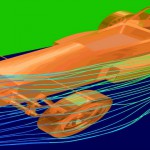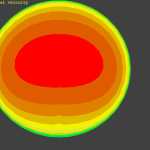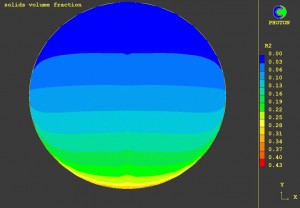PHOENICS-Direct SimScenes
What is a Sim-Scene?
A Sim-Scene simulates fluid- and heat-flow in a preselected set of situations, the particular parameters of which are further selected by its user. It does so by transmitting the user's requirements to a powerful but hidden 'simulation engine' and by presenting the latter's responses in a user-understandable form. The 'engine' is PHOENICS software package; and this is an embodiment of the science of Computational Fluid Dynamics. Sim-scene users however need no knowledge of these. A Sim-scene can be thought of, by analogy with the 'apps' which abound for smart-phones and tablet computers, as an 'App for PHOENICS'. Here after are a non-exhaustive list of already developed Sim-scenes. The links will develop more information on each sim scene.

Urban Field
[peekaboo_link name="bar1"]URBAN-VIRTUAL WIND TUNNEL[/peekaboo_link]
[peekaboo_content name="bar1"]
[/peekaboo_content]

Heat Exchanger
[peekaboo_link name="bar2"]HEAT EXCHANGER[/peekaboo_link]
[peekaboo_content name="bar2"]
[/peekaboo_content]
[peekaboo_content name="bar1"]
The function of Urban-VWT is to simulate the air flow around individual or groups of buildings, incorporating measured wind statistics to obtain yearly averaged results for the modeled wind direction. Urban-VWT is intended for architects, building engineers, urban planners, local authorities and environment engineers. Urban-VWT enables users to visualize, understand, evaluate and refine the air-flow patterns in steady-state scenarios, in micro- as well as macro-scale. Transient (time-dependent) conditions are straightforward to implement, if required.
Using UrbanVWT architects, building engineers, urban planners and local authorities can obtain:
- Forces on roofs and walls.
- Pedestrian comfort information.
- Rates of heat loss or gain between buildings, atmosphere and sky.
Concentration of pollutants.
Case studies:
Study at University of Florida
Urban Wind Flows – Large - scale Parallel - processing model
Wind Energy[/peekaboo_content]
[peekaboo_link name="bar2"] [/peekaboo_link]
[peekaboo_content name="bar2"]
The role of HeatEx is to simulate the performance of idealized heat exchangers of parallel-flow, counter-flow, cross-flow and other presumed-flow configurations, both for:
- the circumstances for which analytical solutions exist, i.e. those of uniform fluid properties and uniform overall heat-transfer coefficient, and
- those for which there exist no such solutions, because the said quantities are not uniform, as for example in the shell-and-tube heat exchanger illustrated above.
ShellFlow brochure[/peekaboo_content]

F1 streamlines
[peekaboo_link name="bar3"]F1 - VWT - Formula One Class[/peekaboo_link]
[peekaboo_content name="bar3"]
[/peekaboo_content]

Urban Heat Island
[peekaboo_link name="bar4"]URBAN HEAT ISLAND[/peekaboo_link]
[peekaboo_content name="bar4"]
[/peekaboo_content]
[peekaboo_link name="bar3"] [/peekaboo_link]
[peekaboo_content name="bar3"]
The F1-VWT: Formula One Class scenario has been designed to aid students competing in the Formula One Class of the F1 in Schools challenge. During the analysis phase of the project, Virtual Wind Tunnel Technology can be used to provide far greater flexibility for investigating model designs and the impact which design changes may have on the aerodynamic performance of the model car.
Any number of designs can be tested in the F1-VWT environment without the need to manufacture a single model. Thus, not only does the F1-VWT package offer more flexible use, it also provides a much cheaper and less time consuming means of performing aerodynamic analysis whilst providing far more detailed results.
The purpose of the Formula One Class subdivision of the F1-VWT is to allow students competing within this class to test their models under the constraints of the technical regulations for the Formula One Class. In-built within the class scenario are appropriate legality checks to be considered when designing a Formula One Class model.
F1-VWT brochure[/peekaboo_content]
[peekaboo_link name="bar4"] [/peekaboo_link]
[peekaboo_content name="bar4"]
Heat Isle was originally designed for the simulation of the 'Heat-Island' phenomenon, i.e. the formation of elevated-temperature regions in the vicinity of cities and large towns.
Features of the phenomenon which are disclosed there are:
- That it results primarily from the reduced heat loss by radiation and convection from urban areas in comparison to surrounding vegetation- or water-covered areas, as in the typical plot of near-ground temperatures.
- That it is most pronounced when the velocity of the atmospheric wind is low, so that free (i.e. buoyancy-induced) convection is more important than forced convection.
- That it is to be properly understood only if:
- Long-wave radiation (e.g. from and between buildings) is considered as well as short-wave radiation (i.e. from the sun);
- Radiation absorption, reflection and transmission properties of the atmosphere are taken into account:
- Both day and night are included in the simulation period;
- The differing heat capacities of buildings, soil and vegetation are also considered.
Heat Island brochure[/peekaboo_content]

Flexible tube
[peekaboo_link name="bar5"]TUBE FLOW[/peekaboo_link]
[peekaboo_content name="bar5"]
[/peekaboo_content]

Slurry Particle velocity
[peekaboo_link name="bar6"]TWO PHASE SLURRY[/peekaboo_link]
[peekaboo_content name="bar6"]
[/peekaboo_content]
[peekaboo_link name="bar5"] [/peekaboo_link]
[peekaboo_content name="bar5"]
TubeFlow scenario and PHOENICS-Direct package enable their users, in a very simple and intelligible way
- to simulate both laminar and turbulent steady flow and heat transfer flow inside a tube,
- to vary the fluid properties, input parameters and the various modes of computation,
- to undertake parametric studies by means of the multi-run facility, and
- to examine the results by examination of both graphical displays and printed documents.
[/peekaboo_content]
[peekaboo_link name="bar6"] [/peekaboo_link]
[peekaboo_content name="bar6"]
The Slurry scenario simulates the steady, two-phase flow of a sediment-laden fluid through a straight pipe of circular cross-section.
The purpose of the Slurry simulation scenario (SimScene) is to enable non-CFD experts to predict the pipe pressure gradient, the solids volume fraction distribution and the velocity distribution within the pipe for such a flow set-up.
Case study:
Water Slurry Flows in a Horizontal Pipe[/peekaboo_content]

[peekaboo_link name="bar7"]ALGEBRAIC SOLVERS[/peekaboo_link]
[peekaboo_content name="bar7"]
[/peekaboo_content]
PHOENICS - Direct
If you like to have more information about one (or all of the sim - scene). Please
[peekaboo_link name="car2"]Contact Sales[/peekaboo_link]
[peekaboo_content name="car2"]
Thank you for your interest in our products and services.
if you would like to speak to a Sales Representative about PHOENICS SIM-Scenes, please fill out the following form:
[/peekaboo_content]
[peekaboo_link name="bar7"] [/peekaboo_link]
[peekaboo_content name="bar7"]
The Solvers SimScene contains set of tests for all the linear-equation solvers which have been introduced into PHOENICS.
he full list of solvers is:
- default, which is Stone-like solver with block-correction, but without print-out;
- Conjugate Residual Solver (KIVA-II) with several pre-conditioners;
- MADI, which is modification of well-known ADI solver;
- PHOENICS's solver (PHSOL), which is the same as default, but with detailed print-out;
- Conjugate Gradient (SK_CG) is standard conjugate gradient solver with some pre-conditioners (from SPARSEKIT);
- Conjugate Gradient Method (Normal Residual equation) (CGNR) with some pre-conditioners (from SPARSEKIT);
- Bi-Conjugate Gradient Method (BCG) with some pre-conditioners (from SPARSEKIT);
- Bi-Conjugate Gradient Method with partial pivoting (DBCG) with some pre-conditioners (from SPARSEKIT);
- Bi-Conjugate Gradient Method stabilized (BCGSTAB) with some pre-conditioners (from SPARSEKIT);
- Transpose-Free Quasi-Minimum Residual method (TFQMR) with some pre-conditioners (from SPARSEKIT);
- Full Orthogonalization Method (FOM) with some pre-conditioners (from SPARSEKIT);
- Generalized Minimum RESidual method (GMRES) with some pre-conditioners (from SPARSEKIT);
- Flexible version of Generalized Minimum RESidual method (FGMRES) with some pre-conditioners (from SPARSEKIT);
- Direct versions of Quasi Generalize Minimum Residual method (DQGMRES) with some pre-conditioners (from SPARSEKIT);
- Preconditioned GMRES solver (PGMRES) with ILUT pre-conditioner (from SPARSEKIT);
- Conjugate Residual solver (CNGR) with Jacobi or ILU pre-conditioners;
- Modified Strongly Implicit Procedure (MSIP).
[/peekaboo_content]





